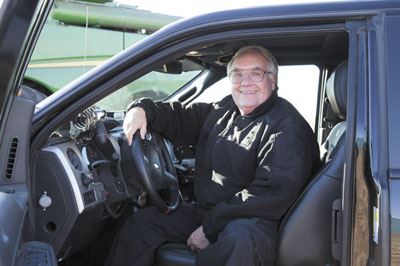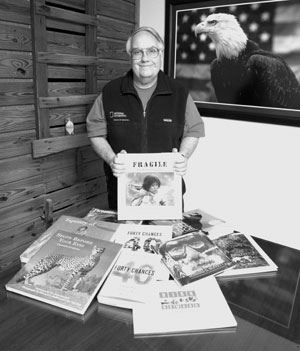|
Playing In The Dirt
Experiments Help Define Best Management Practices
(Part Two of a Four-Part Series)
BETTY VALLE GEGG-NAEGER
MidAmerica Farmer Grower
DECATUR, ILL.
Part of the Howard G. Buffett farming enterprise includes running experiments to determine how to become more efficient.
“We’re trying to experiment right outside this window here,” he said. “We’ve got three 15-acre plots and we’ve got another farm not too far away where we’re replicating it. We’re doing spring ESN and fall ESN drilled. So we’re not spreading it on top like it is designed to be put into the ground.”
He does fall anhydrous, but the spring ESN has out-yielded the fall anhydrous, something that surprised him.
“I thought it would be hard to beat the fall anhydrous. Now we use the full rate of N on that anhydrous. I’m not a fan of putting all the anhydrous on in spring because you don’t know what kind of year it will be, but you have to have a backup plan for that; and if you do not have irrigation you have to have a triple backup plan, a plan A and B when you’re trying to manage your nutrient application. So one idea to avoid getting regulated is to take a drill now and apply nitrogen, drill the cover crops, and if wheat is in the rotation plant the wheat or drill your soybeans. You can use the same piece of equipment four different ways, thereby reducing the environmental impact and reduce your costs.”

Determining how to become more efficient in farming is one reason for running the many experiments from fertilizers to weed control by Howard G. Buffett of Decatur, Ill.
Photo by John LaRose, Jr.
Farmers still tend to look at finding the best hybrid, the appropriate fertilizer and silo it all. Technology, the seed companies and equipment manufacturers help foster that thinking. In the end it should be a really comprehensive system.
Buffett experiments with 90-day corn, 95-96 day corn, 100-101 day corn, 109-112 day corn, studying those yields; his focus also is on timing the planting and taking out of cover crops.
“When we take those crops out, depending on their maturity, it tells us how much less fertilizer we can use as a result,” he said. “So if we plant 105-day corn, and have a reduced yield of 20 bushels an acre, but we reduced our fertilizer, we can actually increase our profit. Less fuel use, less fertilizer use, we’re trying to balance all those economics, while boosting net profit. Higher yield doesn’t always mean higher net profit and I think we get fooled by that so often, that we just think yield, yield, yield.”
Yield is key, however, and success cannot be without yield. But yield does not translate automatically into net profit. Looking at the National Corn Growers Association contest winners, you see their numbers are so unrealistic in terms of how they got to the yield.
“The yield is off the chart but they’d go broke doing it,” Buffett said. “Their input and environmental footprint can be terrible. You have to balance it across the board and we’re trying to figure out what we can do on a large scale that helps us balance all those things out.”
He has worked with Penn State, Purdue, Texas A&M, Michigan State University, UC Davis, and Southern Illinois University out of Carbondale.
“They’re great, they have all their experiments and we’ve given grants to them; we have certain things we’re experimenting with and they come up and do certain things for us, as part of our experiment to help us collect additional data, that we aren’t qualified to collect,” he said. “It’s a great marriage; we butt heads once in a while, particularly with SIU as we’re doing big stuff with them here. We have three different watersheds on 240 acres and they have flues set up to collect data on soil erosion, test water quality and collect chemical data. We’ll change something because that’s how we typically farm it and they’ll pull their hair out and say ‘you can’t change that.’ We’ll answer, ‘we told you we were going to farm it the way we normally farm it.’ There’s that research versus farmer thing, but that’s what we’re trying to do here is figure out how you balance all that out. It’s a learning lesson for us and a learning lesson for SIU. They’ve been great, we couldn’t have picked a better partner. We’re going on our sixth year with them so we know it’s working very well.”
Soil testing is a must with Buffett, and in some cases he actually over-tests.
“We have certain places where we do soil tests every year on a one-acre grid which is pretty intense but we want to make sure we understand the impact,” he said. “So we over-test on some land just to have a better understanding of it. I think soil testing is pretty old fashioned the way we do it. I would expect to see a lot of changes in that in the next 10 years. We’re getting better technology, we’re learning a lot about it and my guess is we’ll be able to use soil tests more effectively 10 years from today than we do today. The big first jump was about 10 years ago when you could do variable rate fertilizer. It’s fun to watch as you put lime and additional fertility on one part of a field, that has historically yielded less, and then you see it spewing record yields. That alone is a huge advance from spreading across the entire field and not getting enough where you need it and putting too much where you don’t need to.”
He sees that success ballooning in 10 or 15 years, something like going from plate to plateless planters. The understanding farmers acquire about raising crops will provide more and more advances.
“The smallest move we make can help us become a lot smarter about how we do things. It takes a lot of time, we experienced a drought that was unbelievable, we had some wet years, but until we get 10 years down the road, we probably don’t have a whole lot to tell people. We have a few things that maybe next year we can start talking about that show trends, but that may not be the final conclusions.”
Weeds are a never-ending problem, especially since Roundup-resistant weeds appeared.
“I raised Roundup soybeans which, for a no-tiller, was like dying and going to heaven,” he said. “It was unbelievable; I used to wish they had Roundup corn and then we got Roundup corn. It’s a great product, but you have to manage it right. If you use the same chemical 10 years in a row, you will have problems. So it isn’t a problem with the product, it’s a great product, it’s a problem with our management practices and I’m guilty of it too.”
Buffett planted Liberty beans last year because the fields were so damaged by the previous drought.
“I was really glad I did. I saw some disaster fields that I’m sure were from using only Roundup. We planted Liberty beans where we thought we needed them and we had good yields and I don’t think I sacrificed much by doing it. We had 65 bushel beans.”
These were not irrigated, but on 160 acres of rolling clay based soils Buffett had some that averaged 62 bushels. On the better black dirt, those averaged 65 bushels.
“We had 66 up at Owaneco, but on one farm they averaged almost 80 bushel an acre and that’s pretty impressive. Now those were Roundup Ready beans. We didn’t have any Liberty to compare that to. In the process of making decisions as you go you have to think about weeds and we have some resistant weeds where we didn’t have them before. Now we’re back to thinking about them. What I find irritating is people who want to criticize Roundup-resistant soybeans; the truth is, myself included, we have to take responsibility for that.”
While farmers try to maximize corn yields they’re becoming so efficient that it becomes inefficient.

Buffett, in 2000 co-published his first book and since has continued to spread knowledge of wildlife and their habitat and the issue of world poverty and hunger through his books and photography. Recently, Buffett, along with his son, Howard W. Buffett, published a book, “40 Chances,” on finding hope in a hungry world.
Photo by John LaRose, Jr.
“I’m guilty of using Roundup Ready beans and corn multiple years in a row and I’m getting what I deserve because I haven’t taken time to rotate as I should or interrupt that chemical activity by using a different program. Chemicals are a fact of life. If you’re going to farm, it’s a matter of having good products, using best management practices and using them safely.
There are other options to curb weeds. Buffett used a rotary hoe last year a few places. “You can even do that in no-till and it has worked. There are some good alternatives. We’re using primarily Roundup Ready beans and trying to do something different on our corn ground; the advantage of having Roundup corn is if you have an emergency you can burn it down and it’ll work on a large part of it. It might not control everything so honestly it’s a management issue.”
Managing fertility is high on his list of concerns. He tries to put nitrogen down four or five different ways.
“I really am a strong believer in a nutrient management plan, so we’ll put on a certain amount of fall anhydrous, then we’ll put on starter; it’s four to five gallons an acre because we put it in-furrow with the planter, and we’ll sidedress. Then in Nebraska my son will put on 25 lbs of nitrogen twice through the pivot. We’ll put it on at different times in different ways. In Nebraska and here, it’s hard to know the economics of this, but we’ll put on 30 lbs. of actual over-the-top nitrogen when we apply our pre-emerge chemical.”
In a no-till system you’ll get some fertilizer into the ground but the microbes get a little bit more so they don’t steal it all; this also breaks down some of the stalks better.
“That’s partly a management decision but I don’t think you’ll ever quantify the nitrogen benefit from it, how much breakdown, how much microbiology benefit there is,” he admitted. “I do it because I think it’s a smart thing to do.”
Buffett has managed to keep pests at bay using rotation; however, except recently he battled cutworm a couple of years in on his Illinois farm.
“The interesting thing for me is this refuge in a bag. I actually like the opportunity to observe what my refuge corn does versus my VT3 corn. Every year we had some refuge corn that has out-yielded our VT3 corn. I’m still trying to figure that out and there are different explanations for it. Now you have refuge in a bag you don’t get to do that anymore. I know a lot of farmers think it’s a great convenience but I don’t like it because it takes away my opportunity to really test things one-on-one, so I’m not a fan of it because I can’t see it. With variety locator on our combine and our ability to record our different varieties on our planter, I can test much more than before.”∆
BETTY VALLE GEGG-NAEGER: Senior Staff Writer, MidAmerica Farmer Grower
Editors Note: Watch for part 3 in next weeks issue #12, of MidAmerica Farmer Grower.
|
|